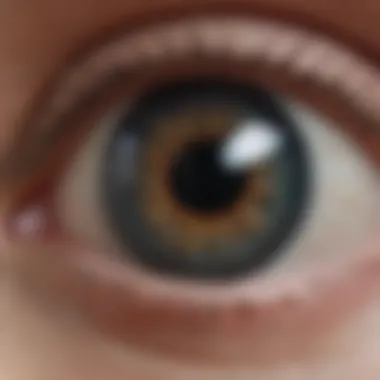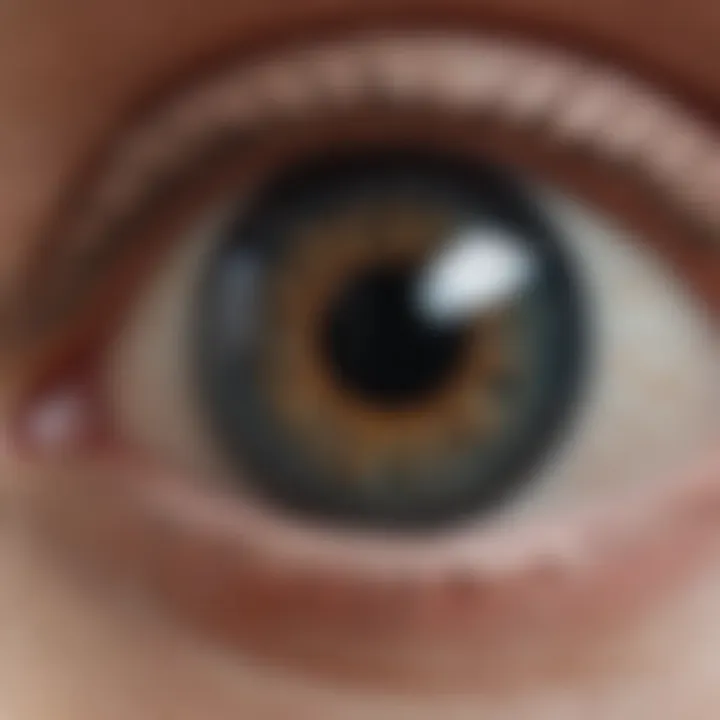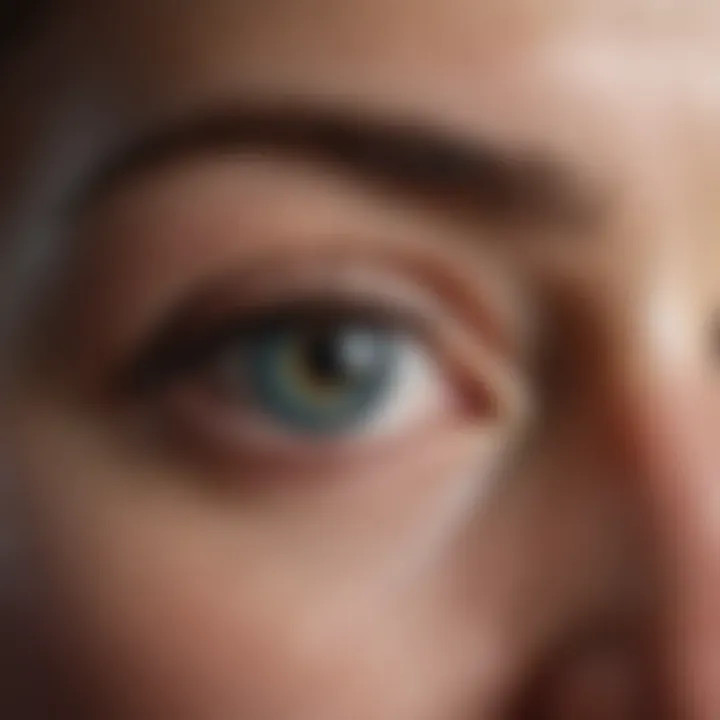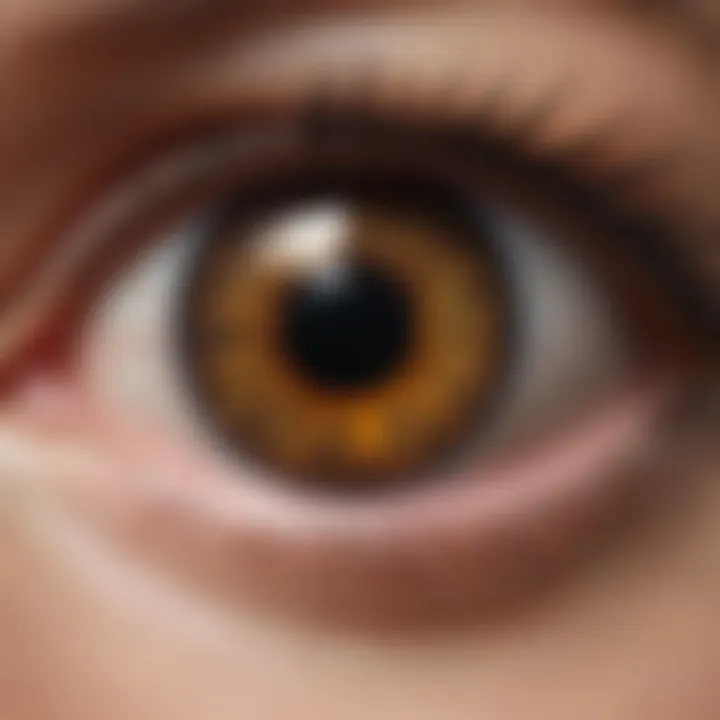Exploring the Multifaceted Functions of Eyes


Intro
The human eye is more than just an instrument for sight. It embodies a complex system enabling various essential functions. Each component contributes not only to vision but also to cognition and emotional processing. Understanding the multifaceted roles of eyes helps clarify their significance in our daily lives.
The intricate structure of the eye allows it to perform several roles. The cornea, lens, and retina collaborate to focus light. This process feeds signals to the brain, facilitating perception and interaction with the environment. Yet, the eyes also play a vital role in non-verbal communication and social interactions. By analyzing the nuances involved in eye behavior, one can gain insights into emotional states, intent, and even health.
In this exploration, we will scrutinize the anatomy of the eyes, their biological significance, and how they influence other cognitive functions. Let’s delve into the workings of this remarkable organ, considering both its evolutionary history and modern implications.
Key Findings
The exploration of the eyes reveals some critical insights:
- Biological functions: The eye's anatomical features serve various functions, from basic sight to sophisticated sensory perception.
- Cognitive effects: Sight significantly influences cognitive processes and emotional responses.
- Health relevance: Eye health is closely linked to overall well-being, affecting both physical and mental domains.
These findings not only contribute to our understanding of eye functions but also hold significance within the broader scientific community. Researchers can connect vision science to behavioral studies, neuroscience, and even health care practices. Increased attention to the role of the eyes encourages interdisciplinary dialogues, fostering advancements in numerous fields.
Implications of the Research
Understanding the multifaceted functions of the eyes has several practical applications. Professionals in healthcare and psychology can implement these insights to enhance patient care and therapeutic approaches.
- Real-world applications:
- Eye examinations can become more holistic, addressing not just vision but also psychological and emotional aspects.
- Educators can design programs considering how visual stimuli impact learning and engagement.
The discoveries surrounding the roles of eyes open pathways for future research. New studies may focus on the neurobiological underpinnings of eye behavior, the impact of technology on vision, or initiatives aiming to promote ocular health. This knowledge encourages deeper explorations into how our eyes influence our lives, potentially benefiting various domains in society.
Prelude to the Eye
The human eye is not merely a window to the world; it is a remarkably complex organ essential for navigating our environment and communicating with others. In this article, we will explore the intricate adaptations of the eye that extend beyond simple vision. Understanding the eye’s anatomy and functions is vital for students, researchers, educators, and healthcare professionals.
Having insight into the eye’s structure allows reader to appreciate its multifaceted roles. The eye comprises various components, each contributing to the overall function of sight. A clear grasp of these aspects is crucial for comprehending more complex phenomena such as visual processing and the relationship between vision and cognition. The intricacies of the eye also bridge connections to broader health implications and social interactions, underscoring its significance in multiple contexts.
Consider the role of the eye in everyday life. Not only does it facilitate seeing, but it also plays a critical part in emotional expression and social bonding. Through subtle cues like eye contact and gaze direction, the eye influences communication and interpersonal relationships. This article will delve deeply into the various aspects of the eye, focusing not only on its biological importance but also on its societal impact.
"The eye is the jewel of the body, reflecting both our inner thoughts and our perceptions of the outer world."
Attention to the eye’s non-visual functions will guide our exploration, revealing how it helps regulate circadian rhythms and contributes to emotional communication. Thus, the introduction sets the stage for a comprehensive narrative that highlights the eye as a vital organ with layers of significance. By understanding the eye from multiple perspectives, we can truly appreciate its role in the human experience.
Anatomy of the Eye
Understanding the anatomy of the eye is essential to grasp its multifaceted roles in both vision and other functions. The eye's structure is a complex composition of external and internal components, supported by various anatomical structures that work cohesively. These elements are not only pivotal for visual perception but also have implications for health and cognitive processing. The anatomy of the eye serves as a foundation for exploring its diverse functions and enhancing our appreciation of this vital organ.
External Structures
Cornea
The cornea is the transparent front layer of the eye. It acts as the primary lens, responsible for focusing light onto the retina. A key characteristic of the cornea is its curved shape which contributes significantly to the refractive power of the eye. Its clarity allows light to pass through efficiently, which is crucial for forming clear images. The unique feature of the cornea is its ability to heal quickly after minor injuries, thanks to the cells that regenerate easily. However, its sensitivity to environmental factors can lead to discomfort or disorders, necessitating protective measures.
Sclera
The sclera is the white outer coating of the eyeball. This structure provides protection and maintains the shape of the eye. One important aspect of the sclera is its thickness, which helps to house the internal structures safely. Its robustness makes it a beneficial choice for discussing eye anatomy. A unique feature of the sclera is its continuous nature, merging with the cornea at the front of the eye. Its structural integrity is crucial; however, conditions such as scleral inflammation can compromise visual function, thus requiring attention.
Eyelids
Eyelids serve multiple purposes, primarily providing protection for the eye and helping to regulate light exposure. The importance of eyelids in maintaining eye health cannot be overstated. They contain muscles that allow for rapid blinking, which distributes tears across the cornea. A distinctive feature of eyelids is their role in non-verbal communication through expressions. This dual function is quite beneficial as it connects bodily functions with social interactions. If eyelids do not function well, it can lead to exposure issues and dry eye conditions, impacting overall vision.
Internal Components
Iris
The iris is the colored part of the eye that surrounds the pupil. It controls the size of the pupil and thus regulates the amount of light entering the eye. The key characteristic of the iris is its muscle structure; it can contract or expand based on lighting conditions. This function makes the iris an important subject in the study of vision. A unique feature of the iris is its pigmentation, which contributes to eye color. Differences in iris health can affect pupil response, which is vital for optimal vision, especially in varying light conditions.
Pupil
The pupil is the opening at the center of the iris. It plays a crucial role in regulating light intake, adjusting its diameter in response to light changes. A key characteristic is its dynamic nature; the pupil dilates in low light and constricts in bright conditions. The pupil's ability to adjust is essential for vision. Furthermore, changes in pupil size can indicate various cognitive states and are significant in clinical assessments. However, abnormal pupil responses can signal underlying health issues, making monitoring important.


Lens
The lens is a transparent structure that further focuses light onto the retina. Its most notable feature is its flexible nature, allowing it to change shape for focusing on objects at different distances, a process known as accommodation. This adaptability is vital for maintaining clear vision at various ranges. As a characteristic of lens health, its clarity is crucial; cataracts can develop over time, leading to opacity and vision loss. Thus, understanding the lens is essential for discussing vision preservation.
Retina
The retina is the light-sensitive layer located at the back of the eye where images are formed. Key characteristics of the retina include its composition of photoreceptors, which convert light into neural signals. This layer is essential as it sends visual information to the brain via the optic nerve. A unique feature is its ability to perceive a wide range of light intensity, enabling night vision. However, retinal conditions such as detachment can be serious, emphasizing the need for regular eye checkups.
Supporting Structures
Ciliary Body
The ciliary body supports the lens and controls its shape for focusing. Its role in accommodation is significant, making it a crucial part of the overall eye function. A key characteristic of the ciliary body is its smooth muscle composition, which allows for precise adjustments when focusing. This control is beneficial because it ensures the lens can perform optimally. Changes in ciliary body function can lead to focusing difficulties, illustrating its importance.
Vitreous Body
The vitreous body is a gel-like substance filling the eye between the lens and retina. It helps maintain the eye's shape and provides support to the retina. A key characteristic of the vitreous body is its transparency, which is essential for allowing light to reach the retina. This structure plays a supportive role but can also contribute to vision issues if it becomes more liquid as one ages. Its changes may lead to floaters or other visual disturbances that need monitoring.
Optic Nerve
The optic nerve transmits visual information from the retina to the brain. Its importance lies in facilitating sight by connecting the eye to the central nervous system. A key characteristic is its collection of nerve fibers, which carry signals from retinal photoreceptors. This connection is crucial for interpreting visual data. Damage to the optic nerve can lead to significant vision loss, underscoring its role in ocular health.
The anatomy of the eye encompasses various elements that not only allow for visual perception but also play essential roles in health and cognitive processes. Understanding these structures is crucial for appreciating their contributions to human experience.
The Physiology of Vision
The physiology of vision is a complex and vital aspect of how we interact with our surroundings. This section explores the mechanisms involved in vision, from the initial reception of light to the intricate processing that enables us to interpret visual information. Understanding these processes is essential, as they not only highlight the sophisticated nature of our eyesight but also underscore the greater implications for cognitive functioning and emotional responses. By dissecting these elements, we begin to appreciate how vision contributes to our perception of reality and influences various aspects of human behavior.
Light Reception
Photoreceptors
Photoreceptors are specialized cells located in the retina that play a fundamental role in receiving light and initiating the process of vision. Two main types of photoreceptors exist: rods and cones. Rods are sensitive to low light conditions and are essential for night vision, while cones operate best in bright light and are responsible for color perception. The key characteristic of photoreceptors is their ability to transduce light into electrical signals that can be interpreted by the brain. This conversion is a crucial step in seeing clearly.
The unique feature of rods is their sensitivity to light levels, making them highly effective in dim conditions, and cones allow for detailed, color-rich vision in bright environments. However, the reliance on rods can lead to a loss of color differentiation under low light, while cones become ineffective in darkness. Thus, understanding the functions of photoreceptors provides insight into both their advantages and limitations within our visual system.
Light Transduction
Light transduction refers to the biochemical process wherein photoreceptors convert light signals into neural signals. This process is vital for enabling the interpretation of visual data by the brain. The key aspect of light transduction is the change in structure that occurs in the photopigments of rods and cones upon exposure to light. This transformation leads to hyperpolarization of the photoreceptor cells, thereby commencing the signaling cascade to the bipolar and ganglion cells of the retina.
A significant advantage of this process is its efficiency in responding to varying light intensities, allowing for adaptive capabilities in different lighting conditions. However, the complexity of this biochemical pathway means that any disturbances can lead to impaired vision. Thus, light transduction is a crucial element is understanding how visual information is processed.
Image Processing
Neural Pathways
Neural pathways refer to the series of connections formed by neurons in the brain that process visual information after it has been received by the eyes. This aspect of vision physiology is complex and involves multiple regions of the brain. The main visual processing pathways include the dorsal and ventral streams, which are responsible for motion detection and object recognition, respectively.
The key characteristic of neural pathways is their ability to integrate various types of visual input, allowing for a cohesive understanding of what we see. They are beneficial in translating raw visual data into meaningful images and help us navigate our environment. However, the sophistication of these pathways can also be a disadvantage, as damage to specific areas can result in visual deficits, illustrating the importance of intact neural networks.
Visual Cortex Function
The visual cortex is a critical region of the brain involved in processing visual information received from the eyes. It is located in the occipital lobe and is responsible for interpreting the signals sent by the neural pathways. A distinctive feature of the visual cortex is its organized structure, where different regions specialize in processing various aspects of vision, such as color, motion, and depth.
One advantage of this highly organized arrangement is its efficiency in handling vast amounts of visual information simultaneously. However, a downside is that any damage to the visual cortex can lead to severe impairments in visual perception, emphasizing the significance of this area in our overall visual experience.
Understanding the physiology of vision helps to highlight the intricate processes that allow us to visualize and interact with our world.
Function Beyond Vision
The eyes are not just instruments for vision; they play multiple roles that transcend seeing. Understanding these roles enhances our comprehension of human behavior and physiology. Specifically, the study of functions beyond vision reveals how our eyes contribute to our overall well-being and interpersonal interactions. By exploring non-visual functions and social cues, this section illustrates the diverse influences of visual perceptions on daily human life, highlighting the broader implications of ocular health on emotional and social dynamics.
Non-visual Functions
Circadian Rhythms
Circadian rhythms are biological processes that follow a roughly 24-hour cycle, influenced significantly by light exposure through the eyes. These rhythms affect sleep patterns, hormone release, and even metabolic functions. Light entering the eye is detected by specialized cells that begin signaling to the brain regarding the time of day. This connection underscores the vital role of eyes in regulating internal bodily functions. Circadian rhythms offer a unique feature as they help synchronize bodily functions to environmental changes, leading to enhanced overall health. However, disturbances in these rhythms can have adverse effects like sleep disorders or mood changes. Therefore, maintaining normal light exposure in daily life can be beneficial for optimizing circadian rhythms.


Emotional Communication
Emotional communication through eye expressions is a fundamental aspect of human interaction. Eyes convey a range of feelings without the need for spoken words. A key characteristic of emotional communication is the subtleties of gaze and eye movement which reflect emotional states, such as happiness or sadness. This underscores why it is so essential for understanding social nuances in interpersonal relationships. A unique feature of emotional communication is its ability to help in building empathy and connecting with others, fostering deeper relationships. However, the reliance on eye expressions can also lead to misunderstandings when non-verbal cues are misread. Therefore, context always matters in accurately interpreting emotional signals through the eyes.
Social Interaction and Nonverbal Cues
Eye Contact
Eye contact holds a significant place in social interactions. It serves as a powerful element in establishing connections during conversations. The key characteristic of eye contact is its ability to convey confidence and attentiveness. This makes it a beneficial choice for effective communication, as it can enhance perceived sincerity and engagement in dialogues. A unique feature of eye contact is that it can serve both positive and negative signals, depending on context. While steady eye contact can foster trust, excessive staring may be perceived as intrusive. Careful consideration of cultural variations in eye contact is also essential, as norms differ widely across societies.
Facial Expression Recognition
Facial expression recognition is critical for socializing and emotional intelligence. Our ability to interpret facial expressions relies heavily on visual information that includes the eyes. The key characteristic of this recognition is the accuracy in deciphering emotions, which can significantly affect interpersonal interactions. Recognizing facial cues can lead to better communication and relationship management, making it a beneficial aspect of social engagement. One unique feature of facial expression recognition is its reliance on learned experiences; familiarity with an individual’s patterns enhances recognition accuracy. However, cultural differences may sometimes hinder the interpretation of facial expressions, possibly leading to miscommunication.
Understanding the multifaceted roles of the eyes not only enriches our grasp of biology but also enhances our awareness of emotional and social dynamics.
The Evolution of Eyes
The evolution of eyes is integral to understanding the multifaceted functions they perform today. Over millions of years, eyes have undergone significant changes, adapting to various environments and survival needs. This adaptability highlights the complexity and sophisticated nature of vision in the animal kingdom. By examining how eyes evolved, we can better appreciate not just their role in vision but also their influence on behavior and interaction with the environment.
Evolutionary Perspective
Ancestral Origins
Ancestral origins of eyes trace back to simple light-sensitive cells. These primitive photosensitive elements allowed organisms to detect light and dark. This basic ability was advantageous in navigating environments. One key characteristic of these early eyes is their simplicity. They provided only basic light detection, yet this was crucial for survival. Their function improved over time, leading to more complex structures found in modern species. This evolution reveals how even the most rudimentary vision can significantly impact survival and reproduction.
The unique feature of these ancestral origins is the gradual complexity that developed, leading to advanced ocular structures. This adaptation has allowed species to evolve in diverse habitats, enhancing survival chances. Understanding this origin is beneficial for grasping more sophisticated features of the eye, such as depth perception and color vision. As research in evolutionary biology continues, it becomes clearer that these origins are not just points of interest. They inform much of what we know today about ocular function and biology.
Adaptive Significance
Adaptive significance refers to the advantages that certain eye traits provide species in navigating their environments. One significant aspect of adaptive significance is the enhanced ability to detect predators or prey, contributing to evolutionary success. This characteristic is crucial as it directly influences survival rates and reproductive success among species. Adaptive features have emerged in response to environmental pressures, ensuring that vision aids survival.
One unique feature of adaptive significance is the variation between species. For instance, nocturnal animals possess larger and more sensitive eyes than those of animals active during the day. The advantages of such adaptations are clear: better night vision leads to increased hunting efficacy and predator avoidance. This section emphasizes the importance of adaptability in evolutionary terms. It shows how diverse ocular adaptations have evolved to meet the complex demands of various environmental conditions.
Comparative Eye Anatomy
Comparative eye anatomy explores the variations in eye structure across species, offering insight into evolutionary adaptations. By studying differences and similarities in ocular anatomy, we gain a deeper understanding of how eyes evolve in relation to traits needed for survival.
Invertebrate Eyes
Invertebrate eyes present a fascinating aspect of comparative anatomy. Many invertebrates, such as insects, possess compound eyes. This structure features numerous lenses, allowing for a broad field of view. A key characteristic of invertebrate eyes is their ability to detect motion very efficiently. This trait is essential for avoiding predators and capturing prey. Their vision is not only about clarity but also encompasses sensitivity to changes in light.
Additionally, the unique feature of invertebrate eyes lies in their diversity. Different species have adapted their ocular structures to optimize for specific environments and lifestyles. For example, the eyes of a dragonfly enable precise movement detection, beneficial for hunting. The advantages include the ability for a wider field of vision and increased reaction times, making it an excellent choice for survival in complex environments.
Vertebrate Variations
Vertebrate variations in eye structure show substantial adaptations linked to lifestyle. A notable aspect includes differences seen in diurnal and nocturnal species. The complexity of vertebrate eyes often involves features such as lenses and retinas that are finely tuned for light absorption.
One key characteristic of vertebrate variation is the presence of fovea, allowing for sharp central vision. This feature is advantageous for activities like hunting or navigating through intricate environments. A unique feature among vertebrates is the development of color vision, especially in primates. This adaptation increases the ability to distinguish ripe fruit and other key resources in the environment.
The benefits of understanding these variations extend beyond mere anatomy. They inform medical research, specifically in the areas of ocular diseases and vision correction. Insight into how different species adapt their eye structures helps in creating applicable technologies and treatments in human medicine, thus tying back to the importance of studying comparative eye anatomy.
Common Ocular Disorders
The topic of Common Ocular Disorders plays a vital role in understanding the overall functionality and health of the eyes. Recognizing these disorders not only aids in awareness but also promotes proactive measures for eye care. The eye is not just a tool for vision; it is an intricate organ that can be affected by various ailments. Addressing these concerns is critical for preserving sight and enhancing quality of life. Thus, a focus on common ocular disorders is essential for anyone interested in ocular health.
Refractive Errors
Refractive errors are among the most prevalent ocular disorders that affect many individuals. These errors occur when the eye cannot focus light correctly on the retina, leading to blurry vision. Understanding their implications contributes significantly to the discussion of visual health and drives home the importance of regular eye examinations.
Myopia
Myopia, also known as nearsightedness, is a common refractive error where distant objects appear blurry. The primary characteristic of myopia is that the eyeball is longer than normal or the cornea has too much curvature. This condition makes it challenging to see objects at a distance. Myopia is particularly relevant in today's digital age, where increased screen time leads to rising incidence rates. Among its notable features, myopia is manageable through corrective lenses or surgical procedures. However, an important consideration is the potential for it to worsen over time if not addressed earlier.
Hyperopia


Hyperopia, or farsightedness, is the opposite of myopia. In this condition, nearby objects may be challenging to see, while distant objects can remain clear. Hyperopia occurs when the eyeball is too short or the cornea is too flat. This disorder's key trait is that it often goes unnoticed until it significantly affects daily tasks like reading or close work. It can result in headaches and eye strain. Corrective glasses and contact lenses are common resolutions, although hyperopia can be more challenging to manage for older adults, as it tends to progress with age.
Astigmatism
Astigmatism is another common refractive error that results from an irregular shape of the cornea or lens. This irregularity causes light to focus on multiple points instead of a single point on the retina, leading to distorted or blurry vision at any distance. A distinctive characteristic of astigmatism is that it often occurs in conjunction with either myopia or hyperopia, complicating the visual issues experienced by an individual. While corrective lenses can help, there's a noticeable drawback: many people may experience challenges adjusting to new prescriptions.
Health Implications
The health implications of ocular disorders extend beyond mere vision problems. Understanding these disorders is crucial as they can also signify underlying health issues or lead to further complications. Awareness of these conditions can prompt individuals to seek timely medical advice, resulting in better long-term outcomes.
Cataracts
Cataracts are a significant health concern, particularly among older adults. Characterized by the clouding of the eye's natural lens, cataracts impede vision by blocking light entry. The unique feature of cataracts is their gradual development, often leading to blurred vision, glare, and difficulties with night vision. They are common and treatable; surgical procedures are effective in restoring sight for many individuals. However, neglecting cataracts can cause significant visual impairment if left untreated.
Glaucoma
Glaucoma represents a group of eye diseases that cause damage to the optic nerve, often associated with elevated intraocular pressure. This disorder is particularly concerning as it can happen silently, often without noticeable symptoms until significant damage occurs. The key characteristic of glaucoma is its progressive nature, often leading to irreversible vision loss. Early detection is crucial, and the use of prescribed eye drops can manage the condition effectively before permanent damage ensues.
Macular Degeneration
Macular degeneration significantly impacts central vision, especially in individuals over 50. This condition deteriorates the macula, an area of the retina responsible for sharp vision, resulting in a gradual loss of ability to see straight ahead. The unique aspect of macular degeneration is that it can be categorized into two types: dry and wet. Current treatments can slow progression but not fully restore vision. The downside is that it severely affects daily activities like reading and driving, significantly impacting quality of life.
"Understanding ocular disorders is vital for preserving not just vision but overall health. Early intervention is essential to mitigate serious consequences."
In summary, discussing common ocular disorders enriches the article by highlighting essential aspects of eye health. Addressing refractive errors acknowledges how prevalent they are in our society. Moreover, understanding ocular health implications furthers the conversation regarding the importance of regular check-ups and proactive measures. This knowledge fosters a deeper comprehension of the eyes' multifaceted roles in overall well-being.
The Future of Ocular Research
The landscape of ocular research is evolving rapidly, driven by technological advancements and an increasing understanding of the eye’s multifaceted roles. Such developments are essential not only for enhancing vision but also for addressing a range of ocular disorders. As the understanding of the eye continues to deepen, exploring future research avenues can lead to substantial benefits for both patients and practitioners.
Technological Advancements
Gene Therapy
Gene therapy stands as a notable advancement in ocular research. This technique involves modifying genes to treat or prevent diseases by delivering genetic material directly to affected cells. One key characteristic of gene therapy is its potential to address the root causes of genetic disorders rather than merely treating symptoms. For patients suffering from conditions such as retinitis pigmentosa, gene therapy presents a revolutionary approach, giving hope where traditional methods fail.
A unique feature of gene therapy is its ability to offer targeted treatments that specifically modify malfunctioning genes. This high specificity can result in fewer side effects compared to conventional therapies. However, despite its promise, challenges such as delivery mechanisms and potential immune responses remain significant. These factors can impact the therapy's effectiveness and overall safety.
Prosthetic Retinas
Prosthetic retinas represent another remarkable innovation in ocular research, aiming to restore vision to individuals with severe retinal degenerative diseases. These devices work by directly stimulating remaining retinal cells, allowing for a modicum of vision restoration. The key characteristic of prosthetic retinas is their capability to provide vision aid, even in cases where natural photoreceptors are no longer functional. This makes prosthetic retinas a substantial option for those with conditions such as age-related macular degeneration.
The unique feature of prosthetic retinas is their integration with electronic components that translate visual information into patterns of light that the brain can interpret. While promising, there are disadvantages, such as high costs and the necessity of surgical intervention. Also, the visual acuity achieved may not fully replicate natural vision, which can pose challenges for users in everyday scenarios.
The Role of Artificial Intelligence
Diagnosing Eye Diseases
Artificial intelligence (AI) has emerged as a powerful tool in diagnosing eye diseases. This technology relies on sophisticated algorithms to analyze medical images, enhancing diagnostic accuracy. The primary characteristic of AI in this context is its ability to process vast amounts of data quickly and efficiently. This leads to earlier and more accurate diagnoses, which are crucial for conditions like diabetic retinopathy.
A unique advantage of AI is its potential to operate in areas with fewer eye care professionals. By automating preliminary assessments, healthcare providers can allocate resources more effectively. However, there are drawbacks, including the need for high-quality data to train AI systems, and the possibility of overlooking subtleties that human specialists might catch.
Enhancing Vision
AI also plays a vital role in enhancing human vision. Advanced image processing techniques can improve visual experiences for individuals with impaired sight. The key characteristic of enhancing vision through AI is personalized solutions, which adjust functioning according to the user's specific needs. This can include customized visual aids and applications that improve daily experiences.
The unique aspect of these AI-driven enhancements is their adaptability; they can learn from user feedback and improve over time. However, as with all technologies, there can be challenges. These include accessibility issues, where individuals might not have the financial means to acquire such technologies. Moreover, ethical concerns regarding data privacy and the reliance on technology also arise.
"Understanding the future directions of ocular research is crucial for optimizing treatment and enhancing the quality of life for individuals with visual impairments."
Culmination
In this article, we have examined the multifaceted functions of the eyes, emphasizing their importance beyond mere vision. The eye serves as a remarkable focal point for understanding human biological and psychological processes.
The eye is essential for interpreting the surrounding environment. Vision is not simply about recognizing shapes or colors; it also involves cognitive processes that influence how we interact with the world. For instance, visual information is integrated with subtle cues about social dynamics, thereby impacting communication and emotional expression.
Moreover, we discussed health implications associated with ocular disorders. Conditions such as glaucoma and macular degeneration can significantly affect not just vision but overall quality of life. Understanding these disorders allows for better prevention and treatment strategies, underscoring the connection between ocular health and general well-being.
Additionally, we touched on the future of ocular research, highlighting advancements like gene therapy and the involvement of artificial intelligence in diagnosis. These innovations could revolutionize how we approach eye health and vision enhancement.
"The human eye is a complex organ that plays a crucial role in our ability to function and thrive in everyday life."
Integrating insights from various scientific fields has also provided a clearer view of the evolution of the eye. Recognizing its development informs our understanding of human adaptability in diverse environments.







